初一英语教案人教版Unit28
- 格式:doc
- 大小:34.00 KB
- 文档页数:12
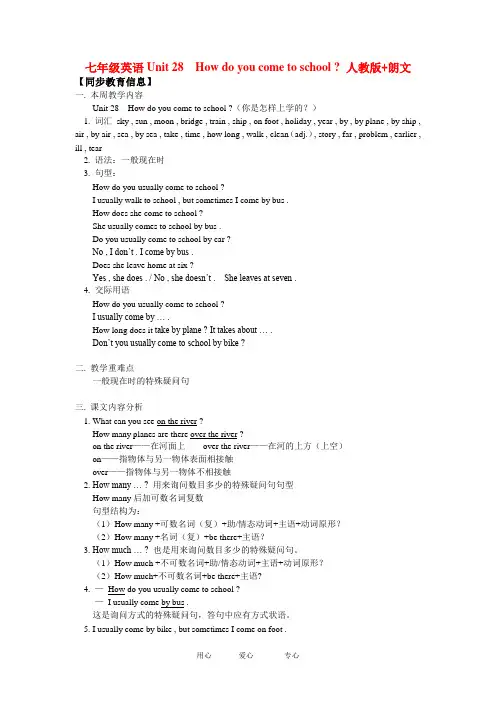
七年级英语Unit 28 How do you come to school ?人教版+朗文【同步教育信息】一. 本周教学内容Unit 28 How do you come to school ?(你是怎样上学的?)1. 词汇sky , sun , moon , bridge , train , ship , on foot , holiday , year , by , by plane , by ship , air , by air , sea , by sea , take , time , how long , walk , clean(adj.), story , far , problem , earlier , ill , tear2. 语法:一般现在时3. 句型:How do you usually come to school ?I usually walk to school , but sometimes I come by bus .How does she come to school ?She usually comes to school by bus .Do you usually come to school by car ?No , I don’t . I come by bus .Does she leave home at six ?Yes , she does . / No , she doesn’t . She leaves at seven .4. 交际用语How do you usually come to school ?I usually come by … .How long does it take by plane ? It takes about … .Don’t you usually come to school by bike ?二. 教学重难点一般现在时的特殊疑问句三. 课文内容分析1. What can you see on the river ?How many planes are there over the river ?on the river——在河面上over the river——在河的上方(上空)on——指物体与另一物体表面相接触over——指物体与另一物体不相接触2. How many … ? 用来询问数目多少的特殊疑问句句型How many后加可数名词复数句型结构为:(1)How many +可数名词(复)+助/情态动词+主语+动词原形?(2)How many +名词(复)+be there+主语?3. How much … ?也是用来询问数目多少的特殊疑问句。
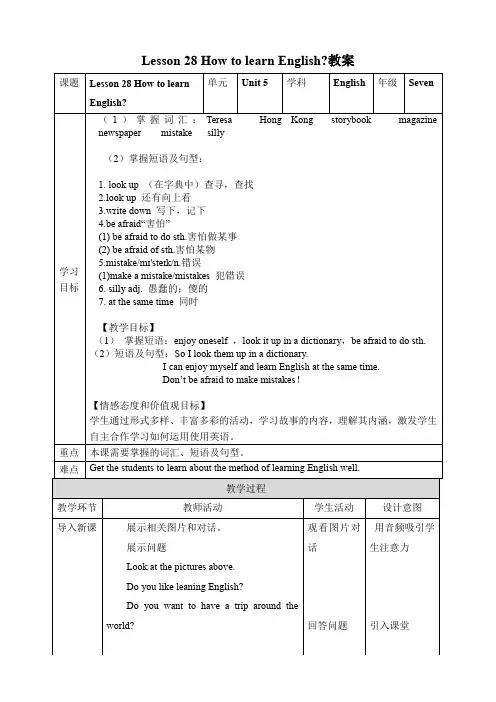
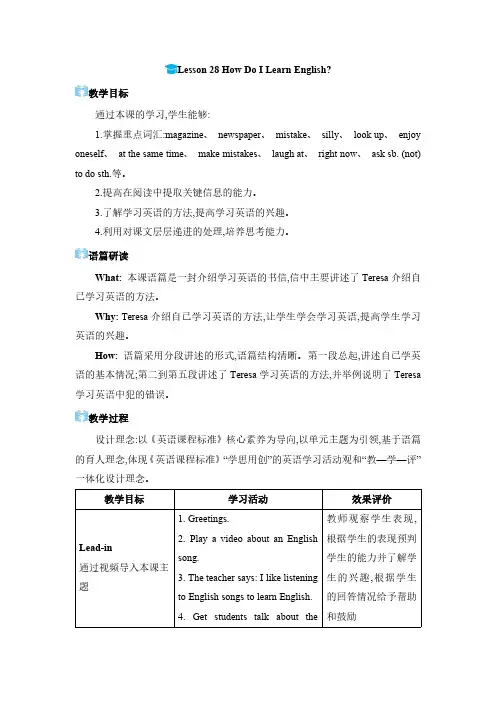
Lesson28How Do I Learn English?教学目标通过本课的学习,学生能够:1.掌握重点词汇:magazine、newspaper、mistake、silly、look up、enjoy oneself、at the same time、make mistakes、laugh at、right now、ask sb.(not) to do sth.等。
2.提高在阅读中提取关键信息的能力。
3.了解学习英语的方法,提高学习英语的兴趣。
4.利用对课文层层递进的处理,培养思考能力。
语篇研读What:本课语篇是一封介绍学习英语的书信,信中主要讲述了Teresa介绍自己学习英语的方法。
Why:Teresa介绍自己学习英语的方法,让学生学会学习英语,提高学生学习英语的兴趣。
How:语篇采用分段讲述的形式,语篇结构清晰。
第一段总起,讲述自己学英语的基本情况;第二到第五段讲述了Teresa学习英语的方法,并举例说明了Teresa 学习英语中犯的错误。
教学过程设计理念:以《英语课程标准》核心素养为导向,以单元主题为引领,基于语篇的育人理念,体现《英语课程标准》“学思用创”的英语学习活动观和“教—学—评”一体化设计理念。
教学目标学习活动效果评价Lead-in通过视频导入本课主题1.Greetings.2.Play a video about an Englishsong.3.The teacher says:I like listeningto English songs to learn English.4.Get students talk about the教师观察学生表现,根据学生的表现预判学生的能力并了解学生的兴趣,根据学生的回答情况给予帮助和鼓励question:How do you learnEnglish?续表教学目标学习活动效果评价设计意图直观视频,导入话题,激发学生兴趣Activity1: Presentation通过图片教授新单词Show the pictures to introduce thenew words.Then practice in class.教师观察学生能否根据旧单词读准新单词,引导学生掌握读单词的方式方法设计意图通过图片教授新单词,同时复习旧单词激活学生已有知识储备,为阅读做铺垫【学习理解】Activity2:Listening 通过听力练习,对文章进行整体感知,为正式阅读做铺垫Get students to listen and doExercise1on page73.What tipsdoes Teresa have for learningEnglish?Listen and tick thecorrect answers.观察学生是否有准确获取有用信息的能力,并给出指导设计意图通过听力提取关于学习英语的细节信息,并使用听中抓取关键词等策略完成听力任务【学习理解】Activity3:Reading 细节阅读,让学生对文本内容进行深度解析1.Fast ReadingWhat’s the main idea of thislesson?2.Careful ReadingTask1:Read paragraph1andanswer questions1-2on page73.Task2:Read the four tips Teresagave and answer questions3-5onpage73.Task3:Read the passage andanswer the questions.(见PPT)观察学生是否能够准确地获取并理解文章的细节,能否在有限的时间内完成相关任务,同时要关注是否能够培养学生的语言运用能力设计意图细读每一段,获取如何学习英语的信息,了解Teresa学习英语的方法及犯的错误。
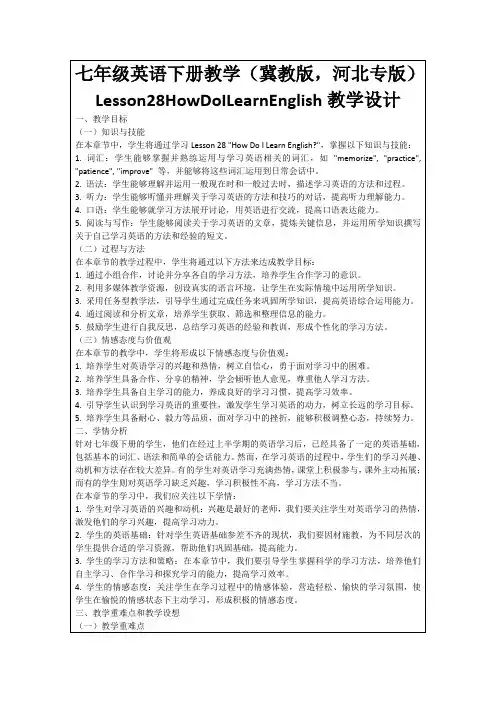
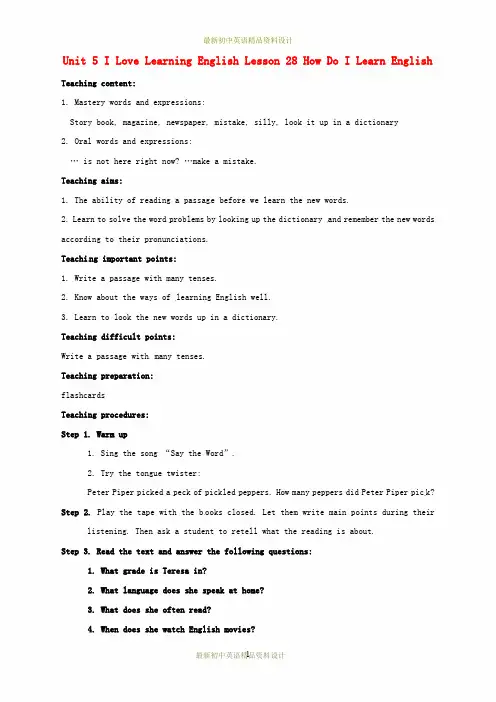
Unit 5 I Love Learning English Lesson 28 How Do I Learn English Teaching content:1. Mastery words and expressions:Story book, magazine, newspaper, mistake, silly, look it up in a dictionary2. Oral words and expressions:… is not here right now? …make a mistake.Teaching aims:1. The ability of reading a passage before we learn the new words.2. Learn to solve the word problems by looking up the dictionary and remember the new words according to their pronunciations.Teachi ng important points:1. Write a passage with many tenses.2. Know about the ways of learning English well.3. Learn to look the new words up in a dictionary.Teaching difficult points:Write a passage with many tenses.Teaching preparation:flashcardsTeaching procedures:Step 1. Warm up1. Sing the song “Say the Word”.2. Try the tongue twister:Peter Piper picked a peck of pickled peppers. How many peppers did Peter Piper pic k? Step 2. Play the tape with the b ooks closed. Let them write main points during their listening. Then ask a student to retell what the reading is about.Step 3.Read the text and answer the following questions:1. What grade is Teresa in?2. What language does she speak at home?3. What does she often read?4. When does she watch English movies?5. Where can you find the words for many English songs?Because the reading is harder, the teacher should check the answers and explain the text when it is necessary.St ep 4. DiscussionSome students may think English is hard to learn. Do they think what is hard to learn English? Ask the students to make a list of the questions they met in their learning.Divide the class into several groups and find the right ways to solve the problems.Give them more time to have a further discussion.Finally the teacher can sum what they say and give them some good advice, too. Step 5. Listen to the text for several times. Let them read after it and imitate until they can read it correctly.Step 6. Let some students read t he text in front of the class. Encourage them to read loudly and imitate the correct pronunciation and intonation.Homework:1. Finish off the activity book.2. Go on reading the te xt.Summary:This passage is about the problems that a girl met in her English learning. She has found the good wa ys to solve them. Some students who are weak in English may have the same problems. So in this class, the teacher should give chance to the poor students. Let them say strai ght and frankly. At the same time, they can improve their spoken English.。
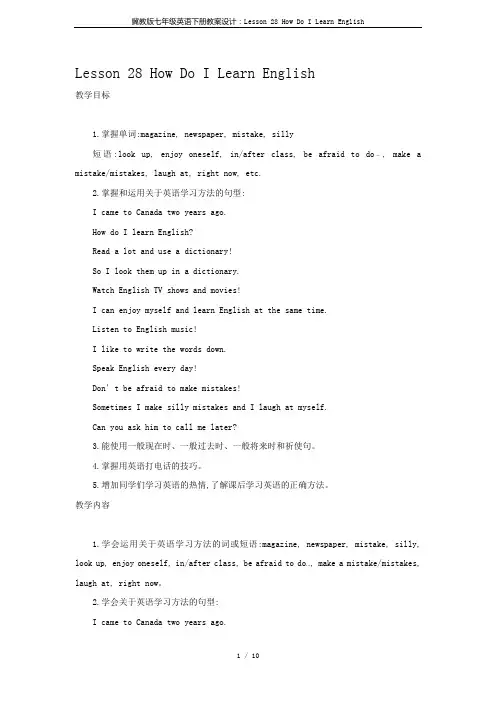
Lesson 28 How Do I Learn English教学目标1.掌握单词:magazine, newspaper, mistake, silly短语:look up, enjoy oneself, in/after class, be afraid to do…, make a mistake/mistakes, laugh at, right now, etc.2.掌握和运用关于英语学习方法的句型:I came to Canada two years ago.How do I learn English?Read a lot and use a dictionary!So I look them up in a dictionary.Watch English TV shows and movies!I can enjoy myself and learn English at the same time.Listen to English music!I like to write the words down.Speak English every day!Don’t be afraid to make mistakes!Sometimes I make silly mistakes and I laugh at myself.Can you ask him to call me later?3.能使用一般现在时、一般过去时、一般将来时和祈使句。
4.掌握用英语打电话的技巧。
5.增加同学们学习英语的热情,了解课后学习英语的正确方法。
教学内容1.学会运用关于英语学习方法的词或短语:magazine, newspaper, mistake, silly, look up, enjoy oneself, in/after class, be afraid to do…, make a mistake/mistakes, laugh at, right now。
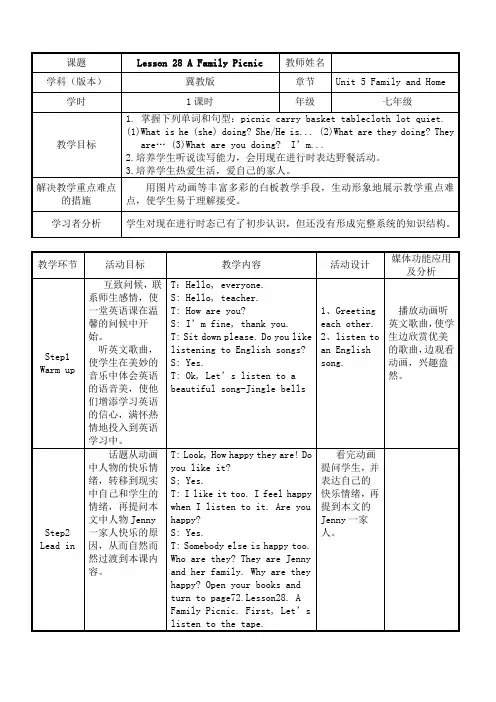
Step6 Summaryand homework对进行时全面总结,使学生对这一时态有一个完整的认识,便于掌握。
填空有利于让学生注意力集中在所填的内容上,达到掌握重点的目的。
作业的目的是让学生进一步巩固现在进行时的结构和用法,以达到熟练掌握。
1. Teacher asks the Ss whatthey learn about the PresentContinuous Tense. Then showthe summary. Ask one studentto read it2. Ask the Ss to read the textagain. Then fill in the blankswith the important points. Askone student to write theanswers on the board.3.Homework:Teacher gives some verbs towrite the composition.For example, run jump, playfootball, play basketball,etc.对现在进行时总结,包括肯定句、否定句、一般问句、特殊疑问句结构。
让学生在背诵的情况下用课文重点短语填空。
教师给出作业:写一篇作文,用现在进行时态描述体育课上的情景。
把现在进行时的各种句子结构,逐一展示给学生,这种视觉效果相当好,大大提高了学生的注意力和理解力,激发了兴趣。
在白板上展示出作业,使学生对要求一目了然。
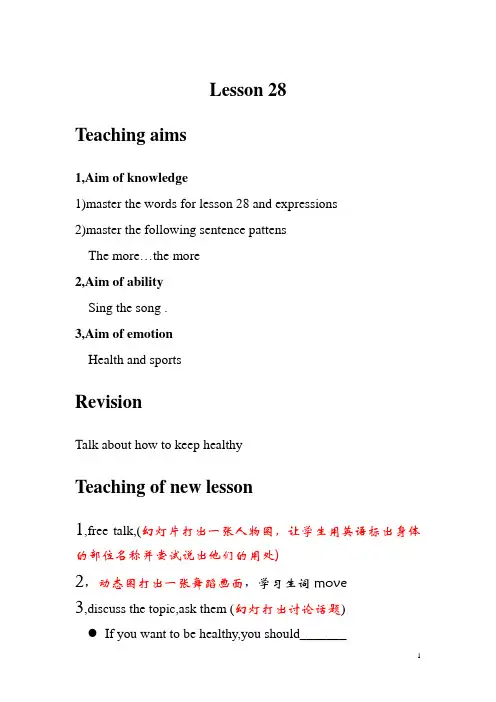
Lesson 28Teaching aims1,Aim of knowledge1)master the words for lesson 28 and expressions2)master the following sentence pattensThe more…the more2,Aim of abilitySing the song .3,Aim of emotionHealth and sportsRevisionTalk about how to keep healthyTeaching of new lesson1,free talk,(幻灯片打出一张人物图,让学生用英语标出身体的部位名称并尝试说出他们的用处)2,动态图打出一张舞蹈画面,学习生词move3,discuss the topic,ask them (幻灯打出讨论话题)If you want to be healthy,you should_______●If you don’t _______,you will______●Don’t ________4,listening,(利用多媒体播放音乐并配合舞蹈)5,divide the class into two groups,Have each group read the song aloud as a poem ,one line at a time,ask one group to read the lines and the other to act out what is being read6,language point(幻灯打出知识重难点)The more you move your feet,the more healthy you will 越。
就越。
,常用句型the +比较级,the +比较级,前者是状语从句,后者是主句,如果主句是一般将来时态,则从句用一般现在时态,例:The more ,the better.The harder you study,the more progress you will make. 7,learn to sing (利用多媒体)If the students already understand the song, play the audiotape,Have the class follow in their student books and sing along with the audiotape.8,practise singing until everybody sings the song well(适当改变歌词中身体部位的名称,让学生跟着音乐作出动作)9,games,(将全班学生分成若干小组,比赛演唱含有身体部位名称的歌曲,唱出歌曲最多的小组获胜10,exercise(用幻灯打出练习题,用以检测和巩固本课的知识点)用所给的词,完成表示“越。
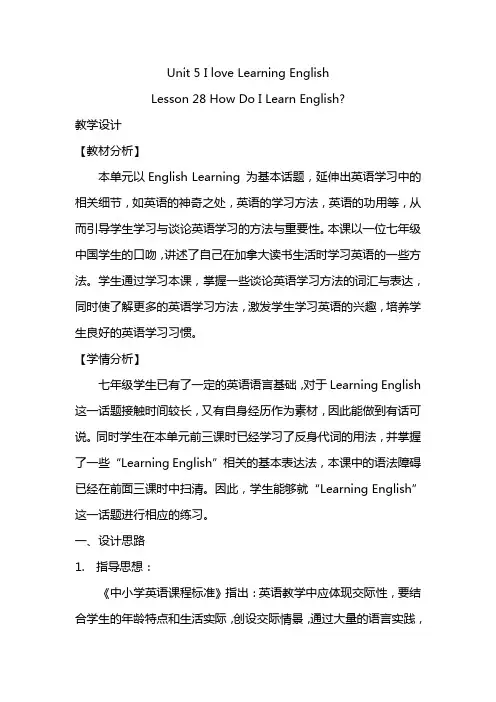
Unit 5 I love Learning EnglishLesson 28 How Do I Learn English?教学设计【教材分析】本单元以English Learning 为基本话题,延伸出英语学习中的相关细节,如英语的神奇之处,英语的学习方法,英语的功用等,从而引导学生学习与谈论英语学习的方法与重要性。
本课以一位七年级中国学生的口吻,讲述了自己在加拿大读书生活时学习英语的一些方法。
学生通过学习本课,掌握一些谈论英语学习方法的词汇与表达,同时使了解更多的英语学习方法,激发学生学习英语的兴趣,培养学生良好的英语学习习惯。
【学情分析】七年级学生已有了一定的英语语言基础,对于Learning English 这一话题接触时间较长,又有自身经历作为素材,因此能做到有话可说。
同时学生在本单元前三课时已经学习了反身代词的用法,并掌握了一些“Learning English”相关的基本表达法,本课中的语法障碍已经在前面三课时中扫清。
因此,学生能够就“Learning English”这一话题进行相应的练习。
一、设计思路1. 指导思想:《中小学英语课程标准》指出:英语教学中应体现交际性,要结合学生的年龄特点和生活实际,创设交际情景,通过大量的语言实践,使学生获得综合运用英语和语言技能进行交际的能力。
针对初中英语新教材容量大的特点,为了使教学面向全体学生,依据本课的课程理念,采用自主阅读为主,课堂小组合作为辅的学习模式,充分发挥学生学习的主观能动性。
2. 教学目标语言知识目标:掌握词汇magazine, newspaper, mistake, silly语言技能目标:让学生了解并介绍自己的英语学习方法。
情感目标:让学生了解如何学好英语3. 教学重点与难点教学重点:(1)掌握一些与介绍英语学习方法有关的词汇:read, write, magazine, newspaper, mistake。
(2)激发学生兴趣,让学生学会介绍自己的英语学习方法。
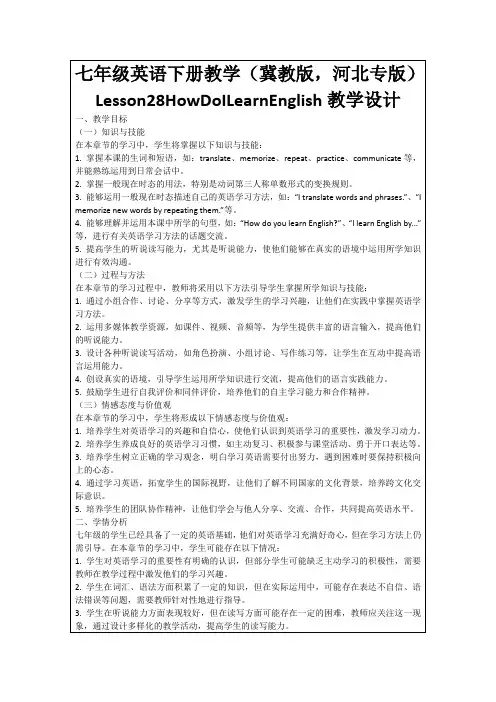
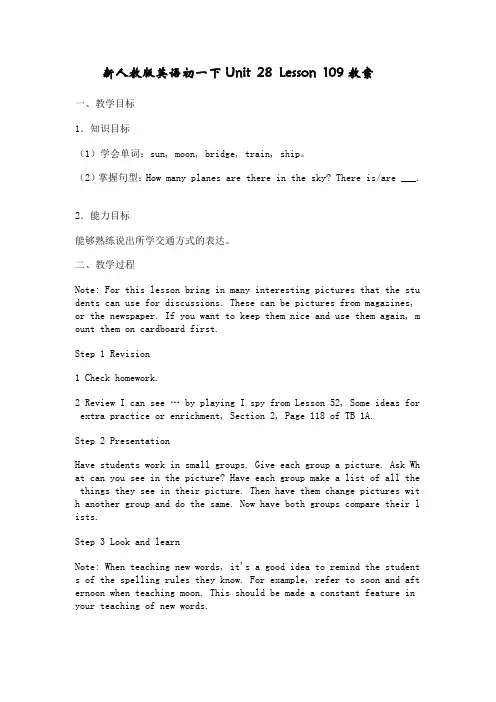
新人教版英语初一下Unit 28 Lesson 109教案一、教学目标1.知识目标(1)学会单词:sun, moon, bridge, train, ship。
(2)掌握句型:How many planes are there in the sky? There is/are ___. 2.能力目标能够熟练说出所学交通方式的表达。
二、教学过程Note: For this lesson bring in many interesting pictures that the stu dents can use for discussions. These can be pictures from magazines, or the newspaper. If you want to keep them nice and use them again, m ount them on cardboard first.Step 1 Revision1 Check homework.2 Review I can see … by playing I spy from Lesson 52, Some ideas for extra practice or enrichment, Section 2, Page 118 of TB 1A.Step 2 PresentationHave students work in small groups. Give each group a picture. Ask Wh at can you see in the picture? Have each group make a list of all the things they see in their picture. Then have them change pictures wit h another group and do the same. Now have both groups compare their l ists.Step 3 Look and learnNote: When teaching new words, it's a good idea to remind the student s of the spelling rules they know. For example, refer to soon and aft ernoon when teaching moon. This should be made a constant feature in your teaching of new words.SB Page 56, Part 1. Teach sun, moon, bridge, train, taxi, and ship. U sing the picture, explain that the is used for unique natural element s, such as the sun and the moon. Practise this chain drill with the s tudents:A: (Looking at the picture)What can you see in this picture?B: I can see the .sun. What can you see in this picture?C: I can see the moon, etc.Step 4 Ask and answerSB Page 56, Part 2. In pairs have the students ask each other questio ns concerning the picture in Part 1. They can use the model to help t hem.Step 5 Guessing gameFor this game, have several pictures of vehicles, e.g. a bus, car, pl ane, etc. drawn on pieces of paper. The object is to have the student s guess what type of vehicle is in the picture by asking questions ab out it. Hold up the paper and ask What kind of vehicle (运输工具) is this? Can you guess? Help the students to ask questions like, Can man y people sit in it? Does it go fast / slow? Does it go in the sky? Do es it go on the water? How many doors does it have? etc. The person w ho guesses correctly, can then come up and hold the next picture and ask the class questions.Step 6 Ask and answerSB Page 56, Part 3. Ask the students questions like, Is /Are there …? Are there any birds in the picture? How many … are there in the s ky / on the bridge … ? Then let the students work in pairs, asking e ach other questions. Now books closed! Ask the students questions abo ut the picture and see if they can answer from memory.Step 7 WorkbookSB Page 137, WB Lesson 109, Ex. 1-4. Do all these exercises orally in class. When doing Ex. 2, you may explain why a / an / the is used. I f necessary, briefly review the rules for choosing the correct articl e.Get individual students to do Ex. 4. Help when needed if they have tr ouble with the translation.HomeworkLearn the new words in this lesson.Write the sentences in Ex. 4.。
Lesson 28 How Do I Learn English教学设计【教学目标】1. Lear.th.way.t.lear.English.2. Discus.ho.t.improv.Englis.yourself.3.Encourag.student.t.tr.thei.bes.t.lear.English【教学重难点】重点: 1. Tal.abou.th.way.t.lear.English.2. New words and phrases:two years ago, look it/them up, enjoy oneself, be afraid to do sth. Mak.mistakes...an.s.on.难点: Let the students think and be creative.【课时安排】1课时【教学过程】一、导入环节(2分钟)(一)导入新课, 板书课题导入语:Goo.morning.class.Ho.ar.you.Today.w.ar.goin.t.learn:Lesson 28 How Do I Learn English(二)出示学习目标过渡语:First ,let’s read the learning goals together.1.我要掌握单词和句型: tw.year.ago.enjo.oneself.b.afrai.t.d.sth.Mak.mistakes...2.通过学习, 我要学会如何提高自己的英语水平。
过渡语:I believe everyone can achieve your goal? Can you ? Let’s begin .二、先学环节(15分钟)过渡语:First look at the guides carefully and then finish the tasks step by step.(一)出示自学指导1.熟记单词, 完成自学检测(1)2.读课文, 完成自学检测(2)和Let’s do it(二)自学检测反馈I. 背写本课单词(英语、词性、汉语意思)(1)____________________(2)_____________________(3)__________________ (4)____________________(5)____________________(6)___________________ (7)____________________(8)____________________(9)___________________ 1.Ⅱ.读课文, 找出本课短语并翻译:Loo.u.查.查.2.enjo.onesel.玩得痛快,过得愉.3.alon.wit.与---一起,连.4.b.afrai.t.d.st.害怕做某.5.mak.mistake.犯错ug.a.嘲笑,取.7.righ.no.目前,现.8.thank.for--.因---而感谢(三)质疑问难过渡语:After learning ,do you have any questions? If you have some questions, put up your hands.请你把自学过程中的问题提出来, 然后在班内解决。
初一英语教案人教版U n i t28Unit28 What time do you get up?一、教学目标与要求通过本单元教学,使学生能够运用一现在时描写日常生活、习惯等,并能就上述问题,进行有交际意义的问答。
在本单元学习中,学生们还将复习现在进行时态和时刻表示法等。
二、教学重点与难点1。
句型:l)What time do you get up.2)What time does he/she get up?3)have 作为"吃饭"解的用法。
2。
语法:1)复习一般现在时的用法;2)复习现在进行时;3)复习时刻表示法。
3·日常交际用语:学习描写习惯的、常的学习和工作用语。
三、课时安排本单元共4课时,每课l课时。
第一0九课Lesson One Hundred and Nine一、教学内容1。
词汇(略)。
.2。
句型:l)What time do you get up?2)It's time to do sth.3)Where's he going?4)He's going to schoo1.3·语法:复习must的用法。
二、教具录音机;闹钟;日历等。
三、课堂教学设计1.值日生报告。
教师通过提问形式,与学生复习the days of the week。
出示日历,指出从星期一到星期五这几天可称为"weekdays"(星期六在国外通常和星期日一起被称为:week-end)。
顺便教week和weekdays.这两个单词。
2·打开书,学生看图。
借助插图和实物,教师讲解本课生词。
例如:教师可将闹钟拨到7点,让它响铃。
然后,手举闹钟,让学生看清时间:It's time to get up! 再将闹钟分别拨到其他相应时间,引出:have breakfast,leave home,begin class等短语。
教师领读生词,反复几遍,确信学生初步掌握为止。
Unit 5 I Love Learning English Lesson 28 How Do I Learn English Teaching content:1. Mastery words and expressions:Story book, magazine, newspaper, mistake, silly, look it up in a dictionary 2. Oral words and expressions:… is not here right now? …make a mistake.Teaching aims:1. The ability of reading a passage before we learn the new words.2. Learn to solve the word problems by looking up the dictionary and remember the new words according to their pronunciations.Teachi ng important points:1. Write a passage with many tenses.2. Know about the ways of learning English well.3. Learn to look the new words up in a dictionary.Teaching difficult points:Write a passage with many tenses.Teaching preparation:flashcardsTeaching procedures:Step 1. Warm up1. Sing the song “Say the Word”.2. Try the tongue twister:Peter Piper picked a peck of pickled peppers. How many peppers did Peter Piper pic k?Step 2. Play the tape with the b ooks closed. Let them write main points during their listening. Then ask a student to retell what the reading is about.Step 3.Read the text and answer the following questions:1. What grade is Teresa in?2. What language does she speak at home?3. What does she often read?4. When does she watch English movies?5. Where can you find the words for many English songs?Because the reading is harder, the teacher should check the answers and explain the text when it is necessary.St ep 4. DiscussionSome students may think English is hard to learn. Do they think what is hard to learn English? Ask the students to make a list of the questions they met in their learning.Divide the class into several groups and find the right ways to solve the problems. Give them more time to have a further discussion.Finally the teacher can sum what they say and give them some good advice, too. Step 5. Listen to the text for several times. Let them read after it and imitate until they can read it correctly.Step 6. Let some students read t he text in front of the class. Encourage them to read loudly and imitate the correct pronunciation and intonation. Homework:1. Finish off the activity book.2. Go on reading the te xt.Summary:This passage is about the problems that a girl met in her English learning. She has found the good wa ys to solve them. Some students who are weak in English may have the same problems. So in this class, the teacher should give chance to the poor students. Let them say strai ght and frankly. At the same time, they can improve their spoken English.。
初一英语Unit 28人教朗文版【本讲教育信息】一. 教学内容:Unit 281、语音知识学习并掌握英语连读的规律。
连读:前一个单词以辅音结尾,后一个单词以元音开头时,要把这两个音连起来念,这种情况叫“连读”。
例如:on a farmin a factoryI'm a student. What about you?the right answerget up2、日常交际用语(1)It's time to get up.(2)What day is it today?(3)What time do you leave home on weekdays?(4)He's putting on his school clothes.(5)Don't speak to me now.(6)We have supper in the evening.(7)We have lunch in the middle of the day.(8)I go to school by bike.(9)I get to school at about 7:30.(10)I don't like to be late.(11)I often watch TV, but sometimes I read.3、有用的词汇(1)get up(2)get to school(3)get home/here/there(4)go to bed(5)go home(6)be late/early(7)be over(8)have breakfast/lunch/supper(9)leave home(10)speak to me(11)put on(12)take off(13)begin school/class(14)in the middle of the day(15)by bike(16)every day(17)on Sundays(18)like to do sth.(19)at about ten(20)on weekdays4、语法知识了解一般现在时与现在进行时的用法和结构方面的差别。
初一英语教案人教版Unit28Unit28 What time do you get up?一、教学目标与要求通过本单元教学,使学生能够运用一现在时描写日常生活、习惯等,并能就上述问题,进行有交际意义的问答。
在本单元学习中,学生们还将复习现在进行时态和时刻表示法等。
二、教学重点与难点1。
句型:l)What time do you get up.2)What time does he/she get up?3)have 作为"吃饭"解的用法。
2。
语法:1)复习一般现在时的用法;2)复习现在进行时;3)复习时刻表示法。
3·日常交际用语:学习描写习惯的、常的学习和工作用语。
三、课时安排本单元共4课时,每课l课时。
第一0九课Lesson One Hundred and Nine一、教学内容1。
词汇(略)。
.2。
句型:l)What time do you get up?2)It's time to do sth.3)Where's he going?4)He's going to schoo1.3·语法:复习must的用法。
二、教具录音机;闹钟;日历等。
三、课堂教学设计1.值日生报告。
教师通过提问形式,与学生复习the days of the week。
出示日历,指出从星期一到星期五这几天可称为"weekdays"(星期六在国外通常和星期日一起被称为:week-end)。
顺便教week和weekdays.这两个单词。
2·打开书,学生看图。
借助插图和实物,教师讲解本课生词。
例如:教师可将闹钟拨到7点,让它响铃。
然后,手举闹钟,让学生看清时间:It's time to get up!再将闹钟分别拨到其他相应时间,引出:have breakfast,leave home,begin class等短语。
教师领读生词,反复几遍,确信学生初步掌握为止。
3·合上书,完整地放课文录音。
教师先板书以下问题:l)What's the time?2)Where is Jimgoing?3)What day is it today?放录音两遍,学生回答黑板上的问题。
再放录音,学生跟读两遍。
教师对一些难点做讲解。
有的句子学生能懂大意即可,不必细讲语法。
有些地方,则需要提醒学生复习。
4·按插图将本课分为两部分,同时把学生分为两人组,每大组演练一部分。
可再放录音,要求学生注意模仿自己角色的语音语调。
经学生演练后,分别从两人组中请几个同学表的。
5,按课文第二项要求,做问答练习。
教师可先与某位同学做示范(提醒学生正确运用"at")。
学生两人一组进行练习。
请两组同学在班上进行问答。
要求全班同学注意听。
在这两人问答结束后,教师可用第三人称单数形式再次提问,并请其他人回答(详细做法,请参阅第79课教案)。
6,指导学生做练习册习题。
7。
布置作业1)抄写生词;2)完成练习册习题。
第一一0课Lesson One Hundred and Ten一、教学内容1.词汇(略)。
2·复习现在进行时态。
3·学习have作为"吃饭"解时的用法。
二、教具录音机。
三、课堂教学设计1.复习。
教师针对第109课对话内容及该课第二部分问答,提出以下问题,要求学生口答,要反应迅速,回答正确。
T:Now Look at the pictures of Lesson lO9.l)What's the time?2)What's Jim doing3)Where is he going?4)What day is it today?5)Is Jim late or early?6)What time do you get up/have breakfast/leave home/begin school on weekdays?7)What time do you get up/have breakfast on Sundays?在问及有关本班学生活动情况时,一人回答之后,教师可立即再问全班:T:What time does he/she get up/leave home…·on weekdays? (参阅第79课教案作法)2·打开课本,学生看图。
借助插图,教师讲解、领读本课生词。
3,用以下步骤,指导学生学习课文第一部分中的句子:T:Now,look at Picture 1. What can you see in the picture?How many people can you see/are there in the picture?Where are they?What's the time?What are they doing?What do they do in the morning?利用每一张画,使学生得到充分练习。
4·放课文第二部分录音,学生跟读两遍。
两人一组用书上所给的问题进行问答练习。
5·指导学生做练习册习题。
6·布置作业1)抄写生词32)完成练习册习题。
四、难点讲解1.We have lunch in the middle of the day·我们每天在正午吃中饭。
in the middle of the day 指中午12点左右这一段时间。
这句话也可以说成:We have lunch at noon every day.2.He is taking off his clothes and going to bed.他正在脱衣服准备睡觉。
take off是"脱下、摘下"的意思,后面常接表示衣物鞋帽的名词。
其反义词是put on。
例如:Take off your old clothes and put on the new ones.脱掉你的旧衣服,穿上这些新的。
第一一一课Lesson One Hundred and Eleven一、教学内容1.词汇(略)。
2.句型,What time do he/she get up?3.日常交际用语,学习描写日常活动的用语。
二.教具录音机。
三课堂教学设计1.复习。
参照上课教案。
2·打开书,学生看图。
针对每幅画,教师可以用下面问题提问:l)What is Han Meimei doing?2)What time does she get up/have breakfast…etc?在问答过程中,讲解出现的生词和短语。
学生两人一组,就书上提供的问题,根据图片进行问答练习。
请两组同学在班上表演。
3.指导学生阅读课文"Jim's Day",在阅读的过程中,如遇到生词,用铅笔划下来。
教师板书以下两个问题:l)What time does Jim get up on weekdays?2)What does Jim do in the evening? 学生阅读一遍课文,回答黑板上的问题。
将自己划出的生词提交给老师。
教师先鼓励学生根据上下文去猜,如猜不出,可直接告诉学生(参照第107课教案的做法)。
领读生词及短语, 反复几遍。
放录音,学生跟读两遍。
打开练习册,口头做习题1。
4·做课文第三项听力练习。
打开练习册,学生准备1分钟。
放录音,学生边听边做习题2。
录音放三通,然后核对答案。
5·指导学生参照课文"Jim's Day",写一篇有关自己一天活动的短文(不少于5句)。
如果时间允许,可请一两位同学在班上朗读自己的短文,教师扼要加以讲评。
(练习册其他题目可留到下一节课去做。
)6·布置作业1)抄写生词,练习朗读本课短文;2)仿照Jim's Day,写一篇有关自己一天活动的短文(不少于5句);3)用笔头形式做习题1。
匹、难点讲解l.What time does he/she get up?他(她)什么时候起床?如果句中主语不是单数第三人称,则句中助动词改为do。
例如:What time do your parents leave home every day?你父母每天什么时候离家去上班?应答时,在表示时间的名词或短语前面加介词at。
例如:They leave home at about 7:2O every day.他们每天大约7点20离家上班。
2.I get to school at about7:3O every day.I get home at about 4:00.我每天大约7点半到校,大约4点到家。
get to是"到达"的意思。
在第二句中,去掉了介词to,是因为home这个单词在句中用作副词。
副词前面一般不能有介词。
到目前我们学过的表示地点的副词有:here(这里),there(那里)。
请看以下例句:Uncle Wang works in a factory.He gets there very early every day.王叔叔在一家工厂工作。
他每天都去得很早。
home也可用作名词,例如,A:Where is Li Lei,do you know?李磊在哪儿,你知道吗?B:I think he's at home.我想他在家呢。
第一一二课Lesson One Hundred and Twelve一、教学内容1.单元复习。
2·初步学习连读的技巧。
3·运用一般现在时。
二、教具录音机。
三、课堂教学设计1.复习。
教师根据第111课的内容,与学生进行问答练习,并可直接问及学生一天的日常活动(参阅前几课教案)。
2·打开书,让学生观察第一部分中列出的短语和句子。
放录音,学生只听不重复,观察有连读符号的处理方法。
教师可扼要介绍连读的技巧。
放录音,学生跟读两遍。
3·放课文第三部分录音,学生跟读,模仿句子重音和语调。
4·指导学生做练习册习题1中的反义词练习。
5·指导学生按自己上一次写的短文,把主要活动填入练习册习题2的表格中。
然后,通过用英语问答形式,把自己同伴的一天情况,记录在自己的练习册上。
例如:S1::What time do you get up on weekdays?S2:,I get up at 7:0O on weekdays.S1在自己练习册上记下时间和get up这一短语即可。
其他活动情况做法相似。
教师也可采用另一方法,即:让每一组中的一个人先读自己的短文,另一人作记录。
6·小结一般现在时表示经常的或习惯性的动作。